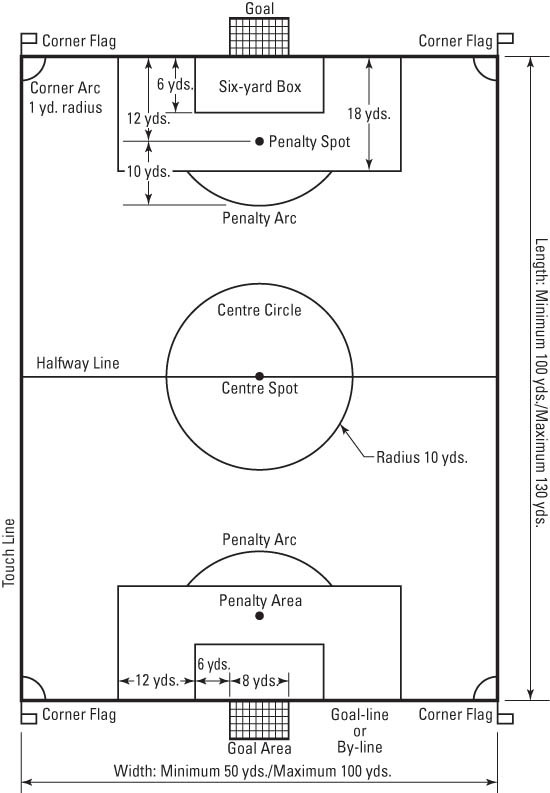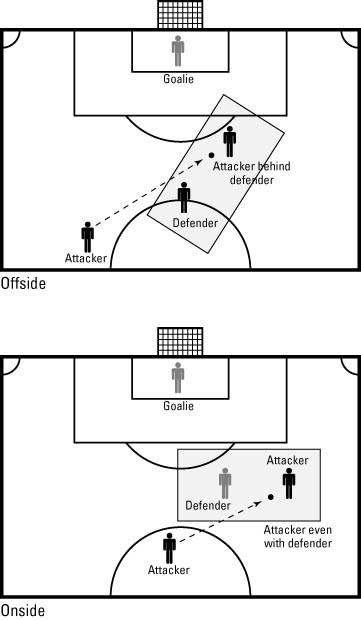Are you an American interested in learning how to play football, the way it’s played in the UK (also known as soccer)? This guide provides a detailed, easy-to-understand explanation of the rules, field, and techniques, perfect for beginners. At CAUHOI2025.UK.COM, we strive to make complex topics clear and accessible, helping you navigate the world of football with confidence, whether you’re a student, professional, or just curious. Delve into football rules, UK football, and basic soccer techniques.
1. Understanding the Football Pitch (Field of Play)
The football pitch, or field of play, is where all the action happens. Familiarizing yourself with its dimensions and markings is the first step in understanding the game.
1.1 Key Areas of the Pitch
- Goal: The ultimate target; scoring means getting the ball into the opponent’s goal.
- Penalty Area: A designated area where fouls committed by defenders result in a penalty kick.
- Center Circle: Used at the start of each half and after a goal is scored.
- Touchlines and Goal Lines: Mark the boundaries of the playing area.
 Football Field Diagram with Key Areas Highlighted
Football Field Diagram with Key Areas Highlighted
Caption: A detailed view of a standard football field with markings, showcasing the penalty area, center circle, and goal lines.
1.2 Dimensions
According to FIFA regulations, the standard pitch dimensions for international matches are:
- Length: 100-110 meters (109-120 yards)
- Width: 64-75 meters (70-82 yards)
It’s worth noting that smaller, non-international pitches may vary in size.
2. The Laws of the Game: Offside Explained
The offside rule (Law 11) is one of the most misunderstood rules in football, often sparking debates and controversies. Here’s a simplified explanation:
2.1 Basic Principle
A player is in an offside position if they are nearer to the opponent’s goal line than both the ball and the second-last opponent.
2.2 What Constitutes an Offside Offense?
A player is only penalized for being offside if they are actively involved in the play. This includes:
- Interfering with play: Touching the ball or impacting a play.
- Interfering with an opponent: Obstructing an opponent’s view or movement.
- Gaining an advantage: Being in an offside position and then receiving the ball.
2.3 Situations Where Offside Doesn’t Apply
A player cannot be offside directly from:
- A goal kick
- A throw-in
- A corner kick
 Diagram Explaining the Offside Rule
Diagram Explaining the Offside Rule
Caption: A visual representation that makes the offside rule easier to understand.
3. Understanding Referee Signals
The referee is the ultimate authority on the field, interpreting and enforcing the laws of the game. Understanding their signals is crucial for players and spectators alike.
3.1 Common Referee Signals
- Direct Free Kick: The referee points in the direction of the attacking team, indicating a direct free kick.
- Indirect Free Kick: The referee raises one arm above their head to signal an indirect free kick. A goal cannot be scored directly from an indirect free kick; another player must touch the ball first.
- Advantage: The referee extends both arms forward, indicating that play will continue despite a foul, as the attacking team has an advantage.
- Penalty Kick: The referee points towards the penalty spot.
Caption: Close-up of a referee signaling a direct free kick, a common sight in football matches.
Caption: Image of a referee signaling the advantage rule, allowing play to continue for the benefiting team.
4. Essential Warm-Up Stretches for Football
Proper warm-up stretches are vital to prevent injuries and enhance performance. These stretches target key muscle groups used in football.
4.1 Recommended Stretches
- Quadriceps: Stand, bend one leg up behind you, and hold your foot. This stretches the front of your thigh.
- Hamstrings and Lower Calf: Sit with one leg extended and reach for your toes, keeping your back straight. This targets the back of your thigh and calf.
- Groin: Sit with the soles of your feet together and gently press your knees towards the ground. This opens up your groin muscles.
- Lower Back: Lie on your back and pull your knees towards your chest. This helps to relieve tension in your lower back.
- Calf Muscle and Achilles Tendon: Stand with one leg forward and bend your knee, pushing against a wall. This stretches your calf and Achilles tendon.
- Hip Flexor: Kneel on one knee with your rear leg bent and your front leg extended. This stretches the front of your hip.
4.2 Importance of Stretching
According to a study by the American Academy of Orthopaedic Surgeons, proper stretching routines can significantly reduce the risk of muscle strains and tears, enhancing overall athletic performance.
5. Basic Skills and Techniques
Mastering basic skills is essential for any aspiring football player. Here are some fundamental techniques to focus on:
5.1 Passing
Accurate passing is the foundation of team play. Practice passing with both feet to improve accuracy and versatility.
5.2 Dribbling
Dribbling allows you to maintain possession and advance the ball. Focus on keeping the ball close to your feet and using quick changes of direction.
5.3 Shooting
Shooting is how you score goals. Practice different shooting techniques, such as instep drives and side-foot placements, to improve accuracy and power.
5.4 Tackling
Tackling is how you win the ball back. Focus on timing and technique to avoid fouls and injuries.
5.5 Heading
Heading is an important skill for both attacking and defending. Practice heading the ball with your forehead, keeping your eyes open and your neck muscles braced.
6. Positions on the Field
Understanding the different positions and their roles is crucial for effective team play:
6.1 Goalkeeper
The goalkeeper’s primary role is to prevent the opposition from scoring. They must have excellent reflexes, agility, and decision-making skills.
6.2 Defenders
Defenders are responsible for protecting their team’s goal. They need to be strong, good at tackling, and able to read the game.
6.3 Midfielders
Midfielders link the defense and attack. They need to be versatile, with good passing, tackling, and shooting abilities.
6.4 Forwards
Forwards are the primary goalscorers. They need to be quick, skillful, and clinical in front of goal.
7. Tactical Formations
A team’s formation determines how players are positioned on the field and how they interact with each other. Common formations include:
7.1 4-4-2
A balanced formation with four defenders, four midfielders, and two forwards.
7.2 4-3-3
An attacking formation with four defenders, three midfielders, and three forwards.
7.3 3-5-2
A flexible formation with three defenders, five midfielders, and two forwards.
8. Common Fouls and Misconduct
Knowing what constitutes a foul is essential for playing fairly and avoiding penalties. Common fouls include:
8.1 Tripping
Intentionally causing an opponent to fall.
8.2 Pushing
Using excessive force to push an opponent.
8.3 Handling the Ball
Deliberately touching the ball with your hand or arm (except for the goalkeeper within their penalty area).
8.4 Dangerous Play
Actions that endanger the safety of an opponent.
Misconduct can result in a yellow card (caution) or a red card (ejection from the game).
9. Rules and Regulations
9.1 Duration of a Match
A standard football match consists of two 45-minute halves, with a short break in between.
9.2 Extra Time and Penalties
If a match is tied after regular time in a knockout competition, extra time (usually two 15-minute periods) is played. If the score is still tied, a penalty shootout determines the winner.
9.3 Substitutions
Each team is allowed a limited number of substitutions during a match.
10. Resources for Learning More
To further your knowledge and skills, consider the following resources:
10.1 Online Tutorials
YouTube and other platforms offer a wealth of instructional videos.
10.2 Local Football Clubs
Joining a local football club is a great way to learn from experienced coaches and players.
10.3 Books and Articles
Numerous books and articles provide in-depth analysis of football tactics and techniques.
11. The Cultural Significance of Football in the UK
Football is more than just a sport in the UK; it’s a deeply ingrained part of the culture. From local pub discussions to national pride, football unites people across the country.
11.1 Match Day Atmosphere
Experiencing a live football match in the UK is an unforgettable experience. The passion and energy of the fans create an electric atmosphere.
11.2 Famous Clubs and Rivalries
The UK is home to some of the world’s most famous football clubs, each with its own unique history and traditions. Intense rivalries between clubs, such as Manchester United vs. Liverpool, add to the excitement.
11.3 The Premier League
The English Premier League is one of the most popular and competitive football leagues in the world, attracting top players and fans from around the globe.
12. How to Get Involved in Football in the USA
Even though football (soccer) may not be as popular as American football in the USA, there are still plenty of opportunities to get involved:
12.1 Youth Leagues
Many youth leagues offer programs for children of all ages and skill levels.
12.2 Adult Leagues
Adult leagues provide opportunities for players of all abilities to compete in organized matches.
12.3 Fan Clubs
Joining a fan club is a great way to connect with other football enthusiasts and support your favorite team.
13. Advanced Tactics and Strategies
Once you have mastered the basics, you can start to explore more advanced tactics and strategies:
13.1 Pressing
Pressing involves aggressively challenging opponents to win the ball back high up the field.
13.2 Counter-Attacking
Counter-attacking is a strategy that focuses on quickly transitioning from defense to attack.
13.3 Set Pieces
Set pieces, such as free kicks and corners, can be crucial opportunities to score goals.
14. Famous Football Players from the UK
The UK has produced some of the greatest football players of all time:
14.1 George Best
An iconic Northern Irish player known for his incredible skill and flair.
14.2 Bobby Charlton
A legendary English midfielder who won the World Cup in 1966.
14.3 David Beckham
A global superstar known for his accurate passing and free kicks.
14.4 Wayne Rooney
England’s all-time leading goalscorer.
15. Physical and Mental Training
15.1 Cardio and Strength
Incorporate cardio exercises like running and sprinting, and strength training like weightlifting to build endurance and power.
15.2 Mental Preparation
Visualize success, manage pre-game anxiety, and maintain focus during matches.
16. Gear and Equipment
Having the right gear is essential for playing football safely and comfortably:
16.1 Shoes
Choose football boots with appropriate studs for the playing surface.
16.2 Shin Guards
Always wear shin guards to protect your legs from impact.
16.3 Apparel
Wear comfortable, breathable clothing that allows for freedom of movement.
17. Injury Prevention
Taking steps to prevent injuries is crucial for staying healthy and on the field:
17.1 Warm-Up and Cool-Down
Always warm up before playing and cool down afterward to prepare and recover your muscles.
17.2 Proper Technique
Use proper technique when tackling, shooting, and heading the ball to avoid injuries.
17.3 Hydration
Stay hydrated by drinking plenty of water before, during, and after playing.
18. The Future of Football
18.1 Technological Advancements
Technology is playing an increasingly important role in football, from video assistant referees (VAR) to wearable performance trackers.
18.2 Global Expansion
Football continues to grow in popularity around the world, with new leagues and tournaments emerging in different regions.
18.3 Inclusivity and Diversity
Efforts are being made to promote inclusivity and diversity in football, ensuring that everyone has the opportunity to participate and succeed.
19. Frequently Asked Questions (FAQ)
Q1: What is offside?
A1: A player is offside if they are nearer to the opponent’s goal than both the ball and the second-last opponent when the ball is played to them.
Q2: How long is a football match?
A2: A standard match consists of two 45-minute halves with a short break in between.
Q3: What happens if a match is tied?
A3: In knockout competitions, extra time (usually two 15-minute periods) is played. If still tied, a penalty shootout decides the winner.
Q4: What is a yellow card?
A4: A yellow card is a caution given to a player for misconduct. Two yellow cards in a match result in a red card.
Q5: What is a red card?
A5: A red card is given for serious misconduct and results in the player being ejected from the game.
Q6: How many players are on a football team?
A6: Each team has 11 players on the field, including the goalkeeper.
Q7: What is the role of a midfielder?
A7: Midfielders link the defense and attack, requiring versatile skills in passing, tackling, and shooting.
Q8: What is a penalty kick?
A8: A penalty kick is awarded to the attacking team when a defender commits a foul inside their penalty area.
Q9: How do you improve your shooting accuracy?
A9: Practice different shooting techniques and focus on proper foot placement and body positioning.
Q10: What is the best way to warm up before a match?
A10: Perform a combination of cardio exercises and dynamic stretches to prepare your muscles.
20. Start Your Football Journey Today!
Learning how to play football in the UK style is an exciting and rewarding experience. With dedication and practice, you can master the skills and tactics needed to succeed on the pitch. Remember to stay informed, practice regularly, and enjoy the beautiful game.
For more information and resources, visit CAUHOI2025.UK.COM. Whether you’re looking for detailed explanations, expert advice, or a supportive community, CAUHOI2025.UK.COM is here to help you achieve your goals. If you have any questions or need personalized guidance, don’t hesitate to contact us through our website. Our team of experts is ready to provide the answers and support you need.
Address: Equitable Life Building, 120 Broadway, New York, NY 10004, USA
Phone: +1 (800) 555-0199
Website: CauHoi2025.UK.COM

